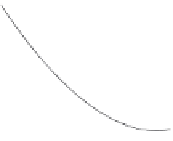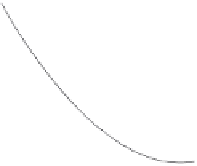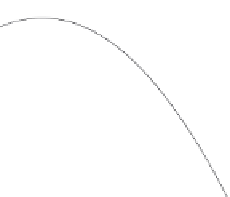Geoscience Reference
In-Depth Information
90
80
70
60
50
40
30
20
10
0
−
10
20
−
−
30
−
40
−
50
−
60
−
70
−
80
−
90
Jan
Feb
Mar
Apr
May
Jun
Jul
Aug
Sep
Oct
Nov Dec
Month
Fig. 2.23 Daily values of solar radiation on a horizontal plane without atmosphere
Q
se
in (W m
−
2
). The
solar constant was taken as
R
so
=
1366 W m
−
2
. The vernal equinox (VE), the summer solstice
(SS) and the autumnal equinox (AE) are indicated by solid vertical lines; the dashed line shows
the solar declination. (From Liou, 2002.)
can be obtained by integration of (2.77) over
dt
=
dh
/ω
between sunrise
h
=−
h
s
and
sunset
h
=+
h
s
, in which
ω
=
2
π
rad d
−
1
=
(
π
/
12) rad h
−
1
. This yields for a horizontal
surface
Q
se
=
(2
R
so
/ω
) (cos
φ
sin
h
s
cos
δ
+
h
s
sin
φ
sin
δ
)
(2.78)
in which the variation in distance from the sun has been neglected. The sunrise and
sunset angle
h
s
can be calculated by putting
β
= π
/
2 or cos
β
=
0; this produces
cos
h
s
=−
tan
φ
tan
δ
. The declination
δ
moves between its extreme values of roughly plus
and minus 23
.
439
◦
between the solstices on approximately June 21 and December 21. It
can be calculated from sin
δ
=
sin
ε
sin
λ
, in which
ε
is the oblique angle (23
◦
17
) and
λ
is
the true longitude angle of the earth with respect to the sun, which varies between 0 at the
spring equinox and
π
at the fall equinox; the matter is somewhat complicated by the fact



























































































































































































































































































